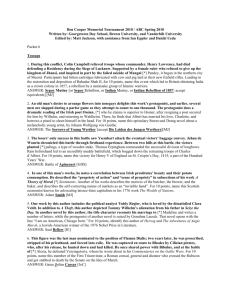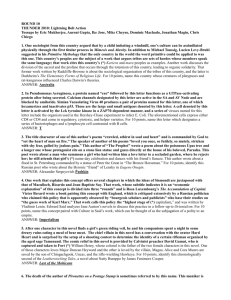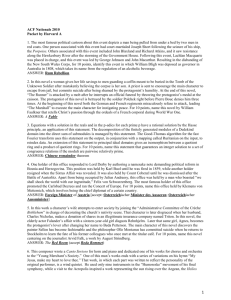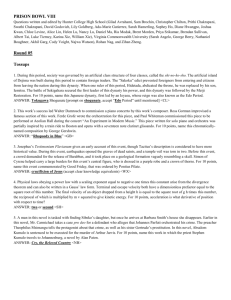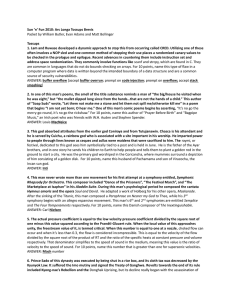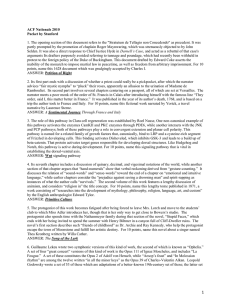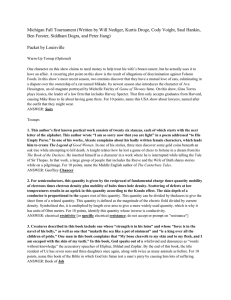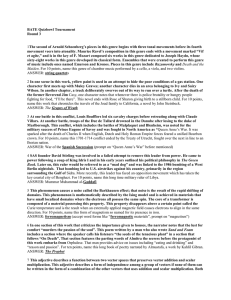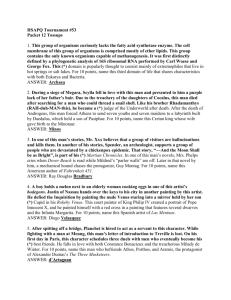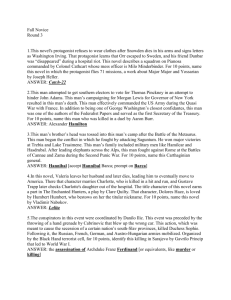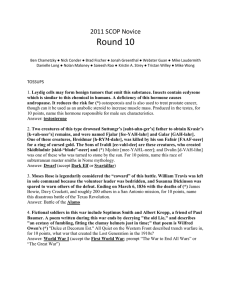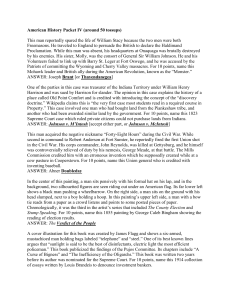Round by Shantanu Jha and Chris Ray
advertisement
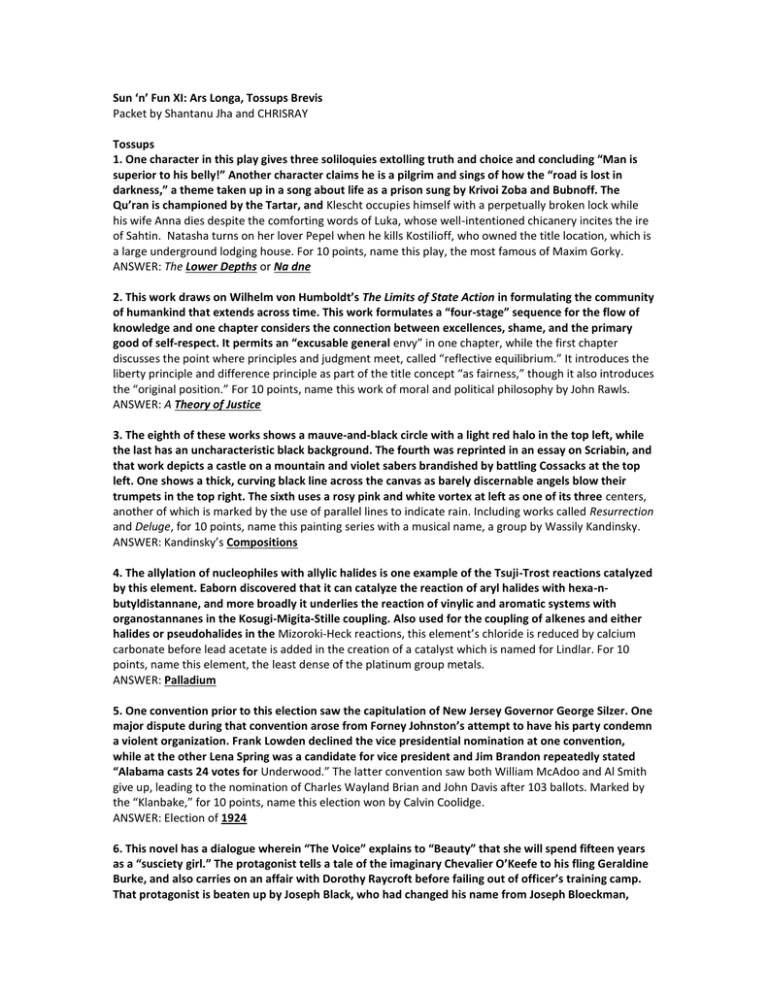
Sun ‘n’ Fun XI: Ars Longa, Tossups Brevis Packet by Shantanu Jha and CHRISRAY Tossups 1. One character in this play gives three soliloquies extolling truth and choice and concluding “Man is superior to his belly!” Another character claims he is a pilgrim and sings of how the “road is lost in darkness,” a theme taken up in a song about life as a prison sung by Krivoi Zoba and Bubnoff. The Qu’ran is championed by the Tartar, and Klescht occupies himself with a perpetually broken lock while his wife Anna dies despite the comforting words of Luka, whose well-intentioned chicanery incites the ire of Sahtin. Natasha turns on her lover Pepel when he kills Kostilioff, who owned the title location, which is a large underground lodging house. For 10 points, name this play, the most famous of Maxim Gorky. ANSWER: The Lower Depths or Na dne 2. This work draws on Wilhelm von Humboldt’s The Limits of State Action in formulating the community of humankind that extends across time. This work formulates a “four-stage” sequence for the flow of knowledge and one chapter considers the connection between excellences, shame, and the primary good of self-respect. It permits an “excusable general envy” in one chapter, while the first chapter discusses the point where principles and judgment meet, called “reflective equilibrium.” It introduces the liberty principle and difference principle as part of the title concept “as fairness,” though it also introduces the “original position.” For 10 points, name this work of moral and political philosophy by John Rawls. ANSWER: A Theory of Justice 3. The eighth of these works shows a mauve-and-black circle with a light red halo in the top left, while the last has an uncharacteristic black background. The fourth was reprinted in an essay on Scriabin, and that work depicts a castle on a mountain and violet sabers brandished by battling Cossacks at the top left. One shows a thick, curving black line across the canvas as barely discernable angels blow their trumpets in the top right. The sixth uses a rosy pink and white vortex at left as one of its three centers, another of which is marked by the use of parallel lines to indicate rain. Including works called Resurrection and Deluge, for 10 points, name this painting series with a musical name, a group by Wassily Kandinsky. ANSWER: Kandinsky’s Compositions 4. The allylation of nucleophiles with allylic halides is one example of the Tsuji-Trost reactions catalyzed by this element. Eaborn discovered that it can catalyze the reaction of aryl halides with hexa-nbutyldistannane, and more broadly it underlies the reaction of vinylic and aromatic systems with organostannanes in the Kosugi-Migita-Stille coupling. Also used for the coupling of alkenes and either halides or pseudohalides in the Mizoroki-Heck reactions, this element’s chloride is reduced by calcium carbonate before lead acetate is added in the creation of a catalyst which is named for Lindlar. For 10 points, name this element, the least dense of the platinum group metals. ANSWER: Palladium 5. One convention prior to this election saw the capitulation of New Jersey Governor George Silzer. One major dispute during that convention arose from Forney Johnston’s attempt to have his party condemn a violent organization. Frank Lowden declined the vice presidential nomination at one convention, while at the other Lena Spring was a candidate for vice president and Jim Brandon repeatedly stated “Alabama casts 24 votes for Underwood.” The latter convention saw both William McAdoo and Al Smith give up, leading to the nomination of Charles Wayland Brian and John Davis after 103 ballots. Marked by the “Klanbake,” for 10 points, name this election won by Calvin Coolidge. ANSWER: Election of 1924 6. This novel has a dialogue wherein “The Voice” explains to “Beauty” that she will spend fifteen years as a “susciety girl.” The protagonist tells a tale of the imaginary Chevalier O’Keefe to his fling Geraldine Burke, and also carries on an affair with Dorothy Raycroft before failing out of officer’s training camp. That protagonist is beaten up by Joseph Black, who had changed his name from Joseph Bloeckman, while this novel sees Maury Noble end up wealthy and Dick Caramel end as a successful though hack writer. Despite being disinherited for his drunken parties, the protagonist ends the novel quite wealthy along with his wife Gloria. For 10 points, name this novel about Anthony Patch by F. Scott Fitzgerald. ANSWER: The Beautiful and Damned 7. Pseudo-Apollodorus relates a story in which this man was killed for assaulting the Hyperborean virgin Upis. Two of his daughters were taught to weave by Athena and sacrificed themselves to end a plague, for which they were turned into comets. Besides fathering Menippe and Metioche, another story suggests he pined for his first wife Side. This son of Hyrieus was guided by the sound of hammers and the boy on his shoulders, Cedalion, to reach Helios, who healed the wounds inflicted on this man for his assault of Merope. Though Oenopion blinded him, many tales state it was a huge scorpion that killed him because he boasted of being able to kill all beasts. For 10 points, name this giant mythological huntsman. ANSWER: Orion 8. Besides his work with Igor Stravinsky, Robert Craft is also known for trying to record all of this man’s works, including a collection that features the pieces “Ausdrucksweise” and “Landsknechte” though it closes with the more homophonic “Verbundenheit.” Besides his Opus 35 6 Pieces for Male Chorus, this man’s Opus 13 is his Friede auf Erden, while his second string quartet ends with a setting for soprano of the poem “Entrückung.” Another work follows an orchestral interlude with the “Voice of the Wood Dove” and has voices representing Waldemar and Tove, characters drawn from the poems of Jens Peter Jacobsen. For 10 points, name this occasionally tonal composer of the Gurrelieder and Pierrot Lunaire. ANSWER: Arnold Schoenberg 9. This dynasty’s reign saw the oft-drunk Bishop Cautinus try to bury the priest Anastasius alive, and the poet Venantius Fortunatus served one queen of this dynasty. Their rule saw the populace rebel against the tax collector Parthenius as well as an uprising by the reprobate prince Chramn. Christianized by men like St. Columbanus, their decline began when judges began to be appointed only within their own regions after the Edict of Paris. Their princesses like Bathilde and Burgundofara often become abbesses and this dynasty ended when Pope Zachary deposed Childeric III, who was replaced by Pepin the Short. For 10 points, name this Frankish dynasty that spawned Clovis and was replaced by the Carolingians. ANSWER: Merovingians 10. The speaker reads in a “light Mosaick” and mentions “strange prophecies my Phancy weaves/And in one History consumes.” After “retiring from the Flood,” this work’s speaker lets himself “imbark/in this yet green, and growing Ark” and it ends with the “salmon-fishers” as “rational Amphibii.” It describes a girl who desires “Heaven’s dialect” named Maria as well as some nuns whose “loudw’st cannon were their lungs” when Isabel Thwaites is rescued from the convent. She goes on to father a hero who “laid these gardens out in sport/In the just figure of a Fort.” Opening “Within this sober Frame expect/Work of no Forrain Architect,” for 10 points, name this poem about the home of Thomas Fairfax by Andrew Marvell. ANSWER: “Upon Appleton House” 11. This man described a “releasement towards being” in On Detachment and, contra Aquinas, argued God was pure intelligence in his Parisian Questions. He argued that we distinguish between God and Godhead “so that we may grasp and eternally enjoy the truth where the highest angel and the fly and the soul are equal” in “Blessed are the Poor,” his famous fifty-second sermon, one of the many in vernacular German. Through such students as Johannes Tauer, he influenced pietism and the Brethren of the Pure Spirit. His Benedictus contains his Book of Divine Consolation, and he never completed his Opus Tripartatum. For 10 points, name this Rhineland mystic who proposed the “spark” of the soul. ANSWER: Meister Eckhart 12. His first album with Verve Records closes with a song in memory of Susan Portlynn Romeo called “Black Swan,” while “Adventures Aboard the Golden Mean” and “Capricorn 2” respectively appear on 2005 and 2003 albums recorded with a group featuring Danilo Perez and John Pattitucci. Besides his work with the Footprints quartet on Beyond the Sound Barrier and Alegria, he collaborated with Milton Nascimento on Native Dancer. Another album features “House of Jade” and “Mahjong,” though his best known effort opens with a song whose melody is mostly perfect fourths, “Witch Hunt.” Known for JuJu and Speak No Evil, for 10 points, name this saxophonist, who, with Joe Zawinul, led Weather Report. ANSWER: Wayne Shorter 13. The presence of beta-2 transferrin is a method used to differentiate this substance, whose electrophoresis in MS patients uniquely displays gamma region spikes known as oligoclonal bands. A study linked violent crime with abnormally elevated levels of a certain protein in this substance while its primary synthesis occurs in the choroid plexus. It enters the bloodstream through the venous sinuses, where specialized villi indent the dura mater from the arachnoid and allow this substance's secretion. Analyzed in a serum albumin ratio test, it is separated from the circulatory system by the bloodbrain barrier. For 10 points, identify this fluid extracted during a lumbar puncture that cushions the brain. ANSWER: CSF or Cerebrospinal fluid [or, apparently, Liquor cerebrospinalis, worst martini variant ever] 14. In late life this man became known as the “Hermit of Turin.” He promulgated the April Laws and, after defeats such as one to Alfred I of Windisch-Grats at the Battle of Schwechat, he released a letter calling his successor Artur Gorgey a “Judas.” This author of the “Cassandra” letter created a stir with Queen Victoria and Lord Palmerston in England with speeches inspired by his love of Shakespeare. Jealously hated by Bertalan Szemare, he was a minister in Count Batthyani’s government, and appealed to Archduke Franz Joseph of Austria before taking over his country in a fit of Magyar nationalism. For 10 points, name this Hungarian journalist who briefly led his nation during the Revolutions of 1848. ANSWER: Lajos Kossuth 15. One of this man’s works repeats the lines “Rome burns/and our slavery begins.” This man described how “it is the cloud that curls to hide the eagle it is the ripple of the stream from bamboo” in “Flutes” and “how the old man’s hands are alligator/skins” in “Duke Playing Piano at 70.” One collection uses the Voodoo prayer “Attibon Legba/ Ouvri bayi pou’moi” as a refrain, while in another collection Sonny Rollins makes “bridges of sound curve” in “Jah.” The latter collection contains a “Limbo” section containing the poem “The Cracked Mother,” and Islands was the last collection in a trilogy including Masks and Rights of Passage. For 10 points, name this author of X/Self and The Arrivants Trilogy who hails from Barbados. ANSWER: Edward Kamau Braithwaite 16. Eloy Burga’s return to this nation sparked conflict with the Pizarro-Rubia casta, partially caused by the discontent Antero Aspillaga, who was cast down by the Partido Civil in favor of Guillermo Billinghurst. Billinghurst was in turn overthrown by the coup of Manuel Prado and Oscar Benavides, and major political parties in this nation’s history include the AP of Fernando Belaunde Terry and Victor Raul Haya de la Torre’s APRA. This nation was home to the La Cantuta Massacre under a leader who also instituted anti-terrorist policies against the followers of a man calling himself President Gonzalo. For 10 points, name this country, home to the human rights abuses of both the Shining Path and Alberto Fujimori. ANSWER: Peru 17. A correction to the Prandtl-Glauert factor for calculating the critical pressure coefficient is named for him and Tsien. A result partially named for this man approximates solutions for the general momentum integral using a fourth degree polynomial and the Pohlhuasen parameter. He also names a formula preferred to the Blasius formula for Reynolds numbers greater than 10 to the fifth; that formula was extended by Nikuradse and relates a coefficient of .4 or .41 to the skin friction coefficient. He also names the continuous shedding of eddies by the cylinder around which a fluid flows, which is his vortex street. For 10 points, name this Hungarian who also names the boundary between the atmosphere and space. ANSWER: Theodore von Karman 18. This work’s title concept is described as the “purest example of the tool.” It also notes that the title concept “the historical symbol of the relative character of existence,” and that “rhythm or symmetry of the contents of life” is one determinant of the “Style of Life.” Divided into “analytic” and “synthetic” halves, it claims the title concept is the “autonomous manifestation of the exchange relation” and that economic activity establishes distance and overcomes it. Written by the author of the essay “The Stranger” and The Metropolis and Mental Life, for 10 points, name this 1907 work of economic sociology by Georg Simmel. ANSWER: Philosophy of Money 19. This novel’s protagonist refuses to sell his romance The Archer of Charles IX to Doguereau. While working for Finot and Lousteau he earns the Cenacle’s enmity for writing an article against his friend Daniel d’Arthez and he also bankrupts his lover, Coralie. This work also sees the lawyer Petit-Claud scheme with the Cointets, and after the protagonist’s clothes cause a scandal with Marquise d’Espard, his rival Chatelet marries his former lover Louise Bargeton. A Spanish priest who is actually Vautrin prevents the protagonist’s suicide and gives him money he sends to his sister Eve and old friend David Sechard. For 10 points, name this novel about the poet Lucien de Rebompre, a work of Honoré de Balzac. ANSWER: Lost Illusions 20. A Sumatran inscription mentioning the merchant guild Nanadesa Tisaiyayirattu Ainnutruvar attests to this polity’s trade with Srivijaya. Their artistic productions included the frescoes at Brihadisvara Temple, as well as their lost sculptures and the Airavateswarar Temple. Durings its reign, Kamban wrote the Ramavatharam, and this polity was known for its port city Poompuhar, a center of the powerful navy that allowed them to defeat the Pandya. They overthrew the Pallava and saw the coexistence of Shaivism and Vaishnavism under the rulers who conquered the Kalinga and built temples at Thanjavur, namely, Rajendra and his father Rajaraja. For 10 points, name this Tamil dynasty that united South India. ANSWER: Chola dynasty Bonuses 1. His mereological essentialism culminated in his view that identity is distinct from the body as described in “On the Simplicity of the Soul.” For 10 points each: [10] Name this man who expanded upon his early article “The Problem of the Speckled Hen” in Perceiving and used the concept of “causal contribution” to defend his notion of free will in Person and Object. ANSWER: Roderick Chisholm [10] Chisholm’s Person and Object offers rather different conclusions than Word and Object, a seminal work by this philosopher who wrote “Two Dogmas of Empiricism.” ANSWER: Willard van Orman Quine [10] Chisholm imagined Adam and Noah switching names in a 1967 article about “Identity through” these concepts. David Lewis argued they are irreducible entities that are quite real in a book about their plurality. ANSWER: Possible Worlds or Modal worlds [or something like “spatiotemporal entities on which modal claims might be true” or whatever gets the point across] 2. Identify the following taxonomic divisions from entirely too graphic information about some unique anatomical features, for 10 points each: [10] Just about the only discernible organ possessed by members of this phylum is the osculum, an excretory hole found near the top of their structures. This phylum is also characterized by supporting structures called spicules and a complete lack of circular, digestive, or nervous systems. ANSWER: Porifera or Sponges [10] Most members of this phylum possess an allegedly “tongue-like” organ known as a radula, which actually takes the form of a poisonous harpoon in its order conidae and horrifyingly allows some of its pulmonate members to be carnivorous. ANSWER: Mollusca or mollusks (pulmonates are land snails and slugs, some of which apparently can eat you!) [10] Some male members of this class rely on the juxta to support their aedeagus, a sex organ that some species chivalrously use to encase their man juice in a spermatophylax “basket” to be presented to the female as a “nuptial gift.” ANSWER: Insectae or Insects 3. He committed suicide after being besieged at Arles and gave the title of Caesar to Constantius. For 10 points each: [10] Name this man who defeated the Gaullish Bagaudae and collaborated with Diocletian on implementing a scorched earth policy against the Alemanni. ANSWER: Maximian [10] Maximian was plagued by the rebellion of this man, who took over part of Gaul and Britain before he was killed by his treasurer Allectus. ANSWER: Carausius [10] Maximian aided the rebellion of his son Maxentius, though Maxentius would drown in the Tiber river while fighting against Constantine the Great at this battle. ANSWER: Battle of Milvian Bridge 4. The protagonists of this work go to see kathakali dancing by Karna and Kunti, and while going to see The Sound of Music, a family comes across a Marxist demonstration where they meet the untouchable Velutha. For 10 points each: [10] Name this novel, which, near its end, sees the fraternal twins Esta and Rahel reunite and make love. ANSWER: The God of Small Things [10] This author of The Ordinary Person’s Guide to Empire wrote The God of Small Things. ANSWER: Arundhati Roy [10] Arundhati Roy recently published these “field notes on democracy” which analyze how Narendra Moodi instigated the 2002 massacre in Gujarat. ANSWER: Listening to Grasshoppers 5. Painted during its artist’s trip to Rome, this work’s background shows a chocolate colored Coliseum, and an antique Greek vase can be seen at top left. For 10 points each: [10] Name this double portrait, whose subjects sit in front of a classical sculpture of Orestes and Electra. It shows the male subject examining his wife’s sketch of that sculpture over a table. ANSWER: Mr. and Mrs. Ralph Izard [accept Izard Double Portrait or anything that gets across it shows the Izard couple] [10] This colonial American artist of portraits like Mr. and Mrs. Thomas Mifflin and Paul Revere painted Mr. and Mrs. Ralph Izard. ANSWER: John Singleton Copley [10] Copley also created this history painting, which shows the title garrison commander being avenged by his black servant. The title figure is seen dying in the arms of the officers as British flags wave amid the smoke and chaos. ANSWER: The Death of Major Peirson 6. In the sixteenth century, Vijñānabhiksu attempted to revive this movement’s earlier theism. For 10 points each: [10] Name this belief system advocated by Īshvarakrsña, which divides existence into twenty five categories, twenty four of which are derived from Prakrti, which exists in dualistic tension with Purusha. ANSWER: Sankhya-yoga [accept Samkhya or anything similar in pronunciation] [10] Sankhya’s dualism was highly criticized by Badarayana and Adi Shankara, both of whom instead advocated this monist philosophy. ANSWER: Vedanta [10] Vedanta is focused on the study of these texts, which include the Manduka and Prasna. Each of them is associated with one of the four Vedas. ANSWER: Upanishads 7. This structure is characterized by the fact that the pre-image of each open neighborhood in the base space has a homeomorphic mapping to the direct product of the base space and the elements of this structure. For 10 points each: [10] Name this construct, whose tangent variety is nontrivial according to the hairy ball theorem. ANSWER: Fiber bundle [accept Vector bundle] [10] The transition functions of a vector bundle form a cocycle, which are the kernels of these constructs. For a sheaf, it is the right derived functor of the global section functor. ANSWER: Cohomology [10] One cohomology theory is named for Eduard Čech, who along with Marshall Stone names a technique that generates a compact space which is of this type. This eponymous T2 space has distinct points, which can be separated by disjoint neighborhoods. Its namesake also has an eponymous dimension for irregular sets. ANSWER: Hausdorff space 8. This period saw uprisings organized by false prophets like al-Aswad, Sajah, and Tulayha, and nearly ended in disaster after Abu Bakr was besieged in Medina. For 10 points each: [10] Identify this series of battles following the death of Muhammad that saw numerous tribes challenge the legitimacy of Islam. In the wake of this conflict, the Islamic wars of expansion began. ANSWER: The Ridda Wars or the Wars of Apostasy [10] Abu Bakr was the first of this group, the first four caliphs who presided over the Muslim world following Muhammad's death. After the death of Ali, they were supplanted by the Ummayads. ANSWER: Rashidun or Rightly-Guided Caliphs [10] Abu Bakr had to be bailed repeatedly during the Ridda by this massive badass, who drove Islamic expansion with victories over the Sassanids at Walaja and the Byzantines at Yarmouk. After losing less than a hundred men while taking Antioch in the Battle of the Iron Bridge, he was fired by Umar for competing for popularity with God. ANSWER: Khalid ibn al-Walid or The Drawn Sword of God or Sayfu Allah al-Maslul 9. This work calls Thomas Wolfe a modern Telemachus who reached the truth that “you can’t go home again” in its fifth chapter “The Delphic Oracle as Therapist.” For 10 points each: [10] Name this work that partially defines its title concept as the capacity to move on “in spite of despair.” Its title is drawn from a work of Paul Tillich. ANSWER: The Courage to Create [10] This existential psychologist wrote The Courage to Create as well as works like Love and Will and The Meaning of Anxiety. ANSWER: Rollo May [10] Rollo May’s emphasis on “will” was partially related to that put forth by this psychologist, who wrote The Trauma of Birth and The Myth of the Birth of the Hero. ANSWER: Otto Rank 10. This man chaired a namesake committee charged with evaluating the Japanese attack on Pearl Harbor. For 10 points each: [10] Identify this jurist who served as the pivotal swing vote between Hughes, Brandeis, Cardozo, and Stone and the conservative “Four Horsemen” during the Roosevelt years, who wrote the opinion striking down the AAA in US v. Butler. ANSWER: Owen Josephus Roberts [10] Roberts may be best known for “the switch in time that saved nine,” referring to his pro-New Deal stance in this 1937 case that overturned Adkins v. Children's Hospital and concerned a Washington minimum wage law. Along with the NLRB-preserving decision in Jones & Laughlin Steel Co., this case ensured the constitutional viability of the New Deal. ANSWER: West Coast Hotel Co. v. Parrish [accept either name] [10] Roberts had a bitter rivalry with this first FDR-appointed justice, who articulated his ardent support for incorporation in his dissent to Adamson v. California. He authored the contentious majority opinion in Youngstown Sheet & Tube Co. and dissented in Griswold. ANSWER: Hugo Black 11. Christopher Marlowe did a blank verse translation of the first book, and a continuation of it was written by Thomas May, who was also the first to translate it into English. For 10 points each: [10] Name this work that features the astrologer Figulus and the witch Erichto, though it focuses on a namesake battle twixt Caesar and Pompey. ANSWER: Pharsalia [10] This exemplar of Silver Age Latin literature wrote Pharsalia. ANSWER: Lucan [10] A poem written in memory of Lucan is included in this collection, which also contains a dedication for “The Hair of Flavius Earinus.” Its fifth and last book ends with the poem “Lament for His Boy.” ANSWER: Silvae 12. The massive book SUMO is a collection of this man’s work. For 10 points each: [10] Name this German born photographer who came to fame for his fashion work in Australia, but is perhaps best known for his erotic photographs for French Vogue and nudes for Playboy. ANSWER: Helmut Newton [10] This American photographer is also known for his nudes, such as those of the dancer Bertha Wardell. Perhaps better known are his many photographs of vegetables, particularly peppers. ANSWER: Edward Weston [10] Edward Weston used many of his photos of the East and South he took on his journey with his wife Claris Wilson for an illustrated edition of this poetry collection. ANSWER: Leaves of Grass 13. When Goibnui slew her son Ruadan, she became the first to perform the “keening,” and may have two sisters of the same name, making her a triple goddess. For 10 points each: [10] Name this sister of Aengus and daughter of the Dagda. ANSWER: Brigit [10] Brigit was married to this tyrannical ruler, whose face once erupted in boils when Cairbe recited a satirical poem. He replaced Nuada as king before being ousted and joining the Fomorians. ANSWER: Bres mac Elatha [10] Bres taught the Tuatha de Dannan to plough food after his loss at the second of these battles, which saw Lugh kill Balor. ANSWER: Second Battle of Magh Tuiredh 14. This battle led to the downfall of Frederick V, the “Winter King” who was installed on the throne of Bohemia to contest the authority of Ferdinand II following the death of Holy Roman Emperor Matthias. For 10 points each: [10] Identify this victory during the 30 Years War for Bucquoy and Tilly over Christian of Anhalt's mercenaries, which saw Bohemian forces driven off the namesake geographical feature. ANSWER: Battle of White Mountain or Battle of Bila hora [10] This other 30 Years War battle saw the defeat of the Heilbronn League under the stewardship of Oxenstierna two years after the Battle of Lutzen. It was the last major victory of the war achieved mainly by Spanish troops. ANSWER: Battle of Nordlingen [10] The Battle of Nordlingen marked a brief resurgence for this Spanish military formation, consisting of large, minimally mobile blocks of pikemen and arquebusiers, which had spent the previous four decades getting trashed by Gustavus Adolphus and Maurice of Nassau. They fell out of favor for good after the Prince of Conde's victory at Rocroi in 1643. ANSWER: The Tercio [I guess “the Third” is an acceptable translation, but it's not really called that] 15. One model for this phenomenon replaces a gas molecule’s translational motion in the z-direction with vibration in a potential well. For 10 points each: [10] Name this phenomenon, which in one equation is modeled by an isotherm derived by noting that the fractional coverage is proportional to the number of filled sites on the surface. ANSWER: Adsorption [10] The Langmuir model for adsorption is extended to multilayers by this equation, which has a namesake constant that is equal to the exponential of the heat of adsorption for the first layer minus the heat of liquefaction all over RT. ANSWER: BET equation or isotherm [take Brunauer-Emmett-Teller in the place of BET] [10] In modeling adsorption, solving the nonlinear Poisson-Boltzmann equation with the constant potential boundary condition is facilitated by applying a relation named for Duhem and this American physicist known for his free energy. ANSWER: Josiah Willard Gibbs 16. In this work, Russ Brissenden writes the formally perfect poem “Ephemera,” which the title character publishes after Russ commits suicide. For 10 points each: [10] Name this novel, whose title character is the author of “Love-cycle” and “The Shame of the Sun” and is rejected by his beloved Ruth Morse, in part for his working class background. He, too, commits suicide. ANSWER: Martin Eden [10] This man wrote the autobiographical Martin Eden as well as novels such as The Sea-Wolf and The Call of the Wild. ANSWER: Jack London [10] This Jack London short story concerns the aging boxer Tom King, who weeps on a street bench after his loss to Sandel. ANSWER: “A Piece of Steak” 17. In this novel, the doctor Isanusi uses medicine made from a tree of witchcraft in Bokone to strengthen the title character. For 10 points each: [10] Name this novel, whose title character confronts The King of the Deep Pool and has his last spark of humanity extinguished by the death of Noliwa. ANSWER: Chaka [10] This man from Lesotho wrote Chaka as well as novels like Traveller to the East and Pitseng. ANSWER: Thomas Mofolo [10] Mofolo also resided in South Africa, a nation home to this author of Slow Man and Elizabeth Costello. ANSWER: J.M Coetzee 18. His works include the Chansons Bretonnes for cello and piano and his love of Rudyard Kipling led to his series of orchestral songs and symphonic poems based on The Jungle Book. For 10 points each: [10] Name this French composer, whose love of Hollywood inspired his Seven Stars Symphony ANSWER: Charles Koechlin [10] Koechlin studied under this man and wrote the first biography of him. His works include two piano quintets, the Dolly suite, and a Requiem in D minor famous for its Pie Jesu soprano aria. ANSWER: Gabriel Fauré [10] Charles Koechlin wrote two works called Primavera for an ensemble of string trio, flute, and this instrument. Claude Debussy wrote a sonata for this instrument, flute, and viola. ANSWER: Harp 19. The third act opens with Mariana reading The Romance of Diego Monzon before her epiphany that she cannot marry Jacinto and must join her father in his austere Christian beliefs. For 10 points each: [10] Name this 1947 play taking place in Renaissance Spain. It concerns the severe ascetic Don Alvaro Dabo, who refuses to go to the New World so he can provide his daughter’s dowry. ANSWER: The Master of Santiago or Le Maitre de Santiago [10] This French playwright of Malatesta expounded his theatrical ideas in “Playwrighting or Bullfighting” and wrote three autos sacramentales, the most famous of which is The Master of Santiago. ANSWER: Henry de Montherlant [10] Montherlant’s tetralogy The Young Girls was translated into English by Terence Kilmartin, also responsible for revising C.K Scott-Moncrieff’s translation of this multivolume work, the most famous by Proust. ANSWER: In Search of Lost Time or Remembrance of Things Past or Le Recherce du Temps Perdu 20. For 10 points each, identify each of the following from chemical kinetics. [10] This law is used to calculate the rate of change for the rate constant of a bimolecular reaction. It takes into account the charges on the relevant species, the original rate constant, and ionic strength. ANSWER: Bronsted-Bjurrum law or effect [10] One can use this approximation to solve differential equations used to find a rate law for the change in concentration of a transient species within a reaction. ANSWER: steady-state approximation [10] The steady-state approximation is used when finding a mechanism according to the method named after this chemist, a method polished by Cyril Hinshelwood. Said method is used to model decomposition reactions in the gaseous phase. ANSWER: Lindemann-Hinshelwood mechanism
